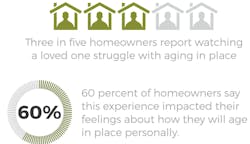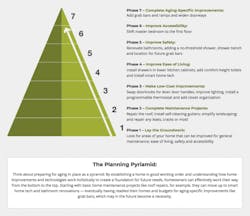In its 2017 Aging in Place report, HomeAdvisor found that homeowners over 55 are typically unfamiliar with the term “aging in place.” Though it has become ubiquitous in the design world—referring to the way accessibility features can allow aging homeowners to live in their homes longer—only 43 percent of participants age 55 to 75 and 52 percent over the age of 75 said they knew the term.
Despite this, 46 percent of respondents had renovated parts of their homes in anticipation of getting older. The most common reason for improvements was “ease of living,” a more relatable term than “accessibility” or “aging in place,” but one with similar implications. Nearly half of respondents had installed comfort-height toilets, replaced appliances, and installed grab bars in their bathrooms, improving their home’s accessibility.
Sixty percent of respondents said they’ve witnessed a loved one struggle with aging in place, making them consider home improvements for themselves. “After seeing what [my family member is] going through, I’m determined to not let it happen to me. I would like to help them, too,” one respondent wrote.
HomeAdvisor suggests starting out with low-cost improvements and maintenance, such as door knob swaps and smart lighting. When bigger aging in place improvements are needed, like a no-threshold shower or wider doors, the home will already have the groundwork in place.
HomeAdvisor suggests starting early with simple home adjustments that ease maintenance and safety. Then the groundwork will be in place for larger aging in place adjustments down the road. / Image courtesy of HomeAdvisor
This story originally appeared in the Jan/Feb 2018 issue of NKBA: Innovation+Inspiration.

